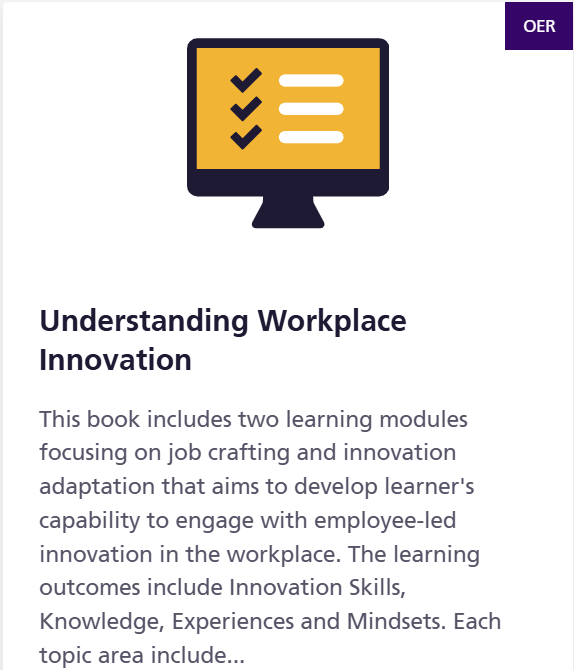… in this post, those instructors summarize some aspects of their context and outline a distinctive aspect of their instructional approach – topical theme, instructional format, host disciplinary program area, etc.– which contributes diverse new thinking to our collective expertise.
Adapting Shared Online Learning Resources on Workplace Innovation for Diverse Postsecondary Contexts (Part II)
Adapting Shared Online Learning Resources on Workplace Innovation for Diverse Postsecondary Contexts (Part I)
In this three-post series, we describe a shared set of online resources and activities to help learners develop their understanding of – and capability for – workplace innovation. These resources are being created, adapted and enhanced by a collaboration across a diverse set of postsecondary institutions. This Collaboration Through Diversity approach has resulted in a rich set of ideas and distinctive versions for specific contexts from which we have all been learning.
Work-in-Progress Update: Designing an Online Resource to Integrate Industry 5.0 into Open Educational Resources on Workplace Innovation
We are engaged in capability development with tertiary education partners across Canada and regional workplace partners in Canada’s “Automobility Hub”. Industry 5.0 concepts are not well-known amongst these companies, except for Canadian companies with European worksites – e.g., Magna International – and a Canadian SMEs integrated into Canadian value chains for European manufacturers.
We report here our in-progress planning to engage those companies through links to Industry 5.0 content in our learning resources on Workplace Innovation. This will come initially through our tertiary education students on-site with them in work-integrated learning placements.
WINCan Team Member Victoria Abboud Awarded a Teaching Medal of Excellence
Congratulations to our WINCan colleague Victoria Abboud, for her Medal of Excellence teaching award from the University of Windsor's Faculty of Engineering. Vicki is leading development of the EMPOWR program to support Engineering graduate students in honing their non-technical ("durable") skills to enhance their impact in Canadian workplaces.
Reflections on Building a Modern 21st Century Workforce (Part II—Industry 5.0)
In Part I of this post, [Dr. Thomas Carey] offered reflections on the discussion paper Building a Modern 21st Century Workforce prepared for Fall 2024 consultations led by the Government of Canada’s Minister of Workplace Development. Those reflections were based on our experiences in the Workplace Innovation Network for Canada, fostering collaborations with workplace and higher education partners to advance employee-led innovation in Canada.
This follow-up post complements those previous reflections with insights specific to another emerging focal point for our current collaborations within Canada and beyond: Developing a distinctive role for Canada in Workplace Innovation Skills for Industry 5.0.
Reflections on Building a Modern 21st Century Workforce (Part I)
In this three-part post, [Dr. Thomas Carey offers his] reflections on the discussion paper Building a Modern 21st Century Workforce prepared for Fall 2024 consultations led by the Government of Canada’s Minister of Workplace Development. These reflections are based on experiences by our team within the Workplace Innovation Network for Canada, around our mission to foster collaborations with workplace and higher education partners to advance employee-led innovation in Canadian workplaces.
Helping Students Develop the Communication Skills They Need to Be Innovation Catalysts
In this post, Rob Danisch, Communication Studies Professor at the University of Waterloo, reflects on the importance of focusing on teaching creative and critical thinking skills to help students become innovation catalysts …
In my case, I’m a Professor of Communication Studies. This means that my classes focus on the kinds of communication practices that can foster or catalyze innovation. It’s not music we are learning to play, at least not necessarily; we are learning an embodied knowledge about our everyday habits of interaction. And I’ve long wanted to teach the embodied communication practices most helpful for creating a culture of learning and catalyzing innovation.
Resources for Building a Sustainable Professional Community for Workplace Innovation Catalysts
Our WINCan team was delighted to be invited to present our current work at the October conference of the EU’s Workplace Innovation Network on The Future of Work. The focus of the presentation was our recent progress on establishing a sustainable Professional Community for Workplace Innovation Catalysts in the Windsor-Essex region, including the larger plan to integrate workplace innovation as a key enabling element in the region’s Innovation Ecosystem.
Case Stories of Workplace Innovation for Science Students – Part II
In Part I of this post, we provided an overview of a WINCan project with our summer research intern – Kyla, an undergrad in the Integrated Sciences program at McMaster University. The aim was to assess the feasibility of creating case stories to illustrate workplace innovation activities that would be of specific interest to Science students. The previous post discusses source material for illustrative case stories for two of the innovation activities – Job Crafting and Innovation Adaptation – in our adaptable learning resources for Understanding and Applying Workplace Innovation.
We follow up in this post with illustrative case story sources for Design Thinking and Intrapreneurship. We also describe a potential practice case story with which students could engage as a test of their understanding, based on a Design Thinking experiment to improve a biochemistry lab course at McMaster.
Case Stories of Workplace Innovation for Science Students – Part I
Three Options for Applying Workplace Innovation Capability in Work-Integrated Learning
Many of the higher education programs and instructors who are partnering with us want to incorporate Work-Integrated Learning (WIL) options into their development of student workplace innovation capability. In this post, we describe three different work-integrated learning opportunities in which initiatives are currently underway.
Toward a Professional Community for Workplace Innovation Catalysts
In a previous post in this series, we highlighted the activities of impacts of a ‘first-generation’ program to develop employees’ capabilities as workplace innovators, the Innovation Catalyst program offered by WEtech Alliance in the Windsor-Essex region of Ontario from 2018 to 2021. One of the insights emerging from that program – and a follow-on project on Inclusive Workplace Innovation for Quality of Work – was the importance of the emerging professional role of Workplace Innovation Catalyst at the program and organizational level.
In this post, we will discuss some of the challenges which arose in sustaining the program as an ongoing offering and in integrating research-based insights into the participants’ practice-based knowledge. We will also describe our work-in-progress plans to address those challenges with a new project aiming to better integrate Workplace Innovation into the regional innovation ecosystem in Windsor-Essex, which includes an innovative knowledge-practice network to support the work of professional Workplace Innovation Catalysts.
Helping International Students Adapt to Canadian Workplaces: “What Does It Mean to be an Innovative Employee”?
In May, I invited WINCan’s Thomas Carey to lead a session for international graduate students at the University of Windsor, on what Canadian employers mean when they include being an “innovative employee” in a job description, and how students could develop and demonstrate the requisite innovation capability. This was the second session in our 5-part Improving Employability Summer Series which I was organizing in my role as a teaching members of the university’s Faculty of Engineering.
Tom’s session on “Becoming an Innovative Employee in Software and Engineering Workplaces” was an initial effort to engage students in considering what it means to be “innovative” in Canadian workplace contexts. In this post, I’ll share what prompted me to develop the series, the purpose of Tom’s specific session, and what we learned through the process.
The Emerging Professional Role of Workplace Innovation Catalyst
Amongst the insights from the FSC research – with workplaces across Canada – was recognition of an emerging professional role for Workplace Innovation Catalysts at the program and organizational level, who could encourage, enable and support workplace innovation initiated and led by other employees (Carey, Frye et al 2023). In this post, we will highlight the activities and impacts of the WEtech Innovation Catalyst program and describe some of what we learned about the Workplace Innovation Catalyst role during our research collaboration.
Looking through the Mirror: Understanding Workplace Innovation as a student Innovation Adaptation Exercise
In March 2024, WINCan’s Dr. Thomas Carey had three guest interactions (virtually) at the University of King’s College to work with students enrolled in a non-credit career development program called Liberal Arts Passport to Innovation. The Passport program is geared towards helping students frame their assets for employers and understand how their liberal arts skills and interests could be a fit with the innovation space. However, it does not teach innovation skills as such. The six student authors listed above were enthusiastic about adding two additional sessions to this co-curicular experience so that they could gain more familiarity with systematic approaches to innovation. A chapter from the WINCan Open Educational Resources (in the eCampus Ontario Open Library) on "Innovation Adaptation” was selected for this purpose and the class then decided to take this WINCan OER resources itself as the Innovation to be considered for adaptation in a pilot project.
Welcoming New Higher Ed Partners for 2024 and 2025
This month, we were delighted to have educators from four new institutions collaborating with us on Developing Student Capability for Inclusive Innovation in the Workplace: …
Each of these new partners – and their distinctive institutions – will add to the diversity of our higher ed team, in line with the innovation team precept that a more diverse team can create greater opportunities for breakthrough innovations. This is also a wonderfully interdisciplinary group, with backgrounds or current responsibilities in the areas of Communications Arts, History, Women’s Studies, Science, Business, English Literature, Health Sciences, Education, Philosophy, Workplace Learning and Employability.
WINCan Workplace Partner Wins National Award in Developing Innovation Culture
For our WINCan team, one of the highlights from last year’s project with the Government of Canada’s Future Skills Centre was the opportunity to interact with the two lead Innovation Catalysts at ENWIN Utilities in Windsor (ON):
Barry Leavitt, ENWIN’s Director of Operations and Innovation (the “Innovation” part of the title having been added to reflect the growing importance of inclusive workplace innovation at ENWIN), and
Rosana Kemsley, ENWIN’s Manager of Human Resource Services.
Inclusive Innovation Initiatives at National, Regional and City Levels
In a previous post in this series, we explored a reframing of Workplace Innovation as Inclusive Innovation at the Workplace level. The larger framework of Inclusive Innovation aims to expand the range of people who participate in innovation and who benefit from its impacts.
The scope of Inclusion Innovation has been expanding to consider the impacts of innovation on the environment we share with other forms of life. Inclusive Innovation has also become a lens through which to expand participants and beneficiaries in global initiatives like the United Nation’s Sustainable Development Goals:
Workplace Innovation for Quality of Work: Research Synthesis and Recommendations on Adaptation for Canadian Contexts
The full results from our 2022-23 applied research project with Canada’s Future Skills Centre are now available on their website.
We’ve copied below the Executive Summary, as well as the Key Insights from the project. You can also download the full report, or read more on the FSC Site for these topics:



















